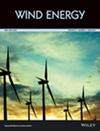Noise simulations of flap devices for wind turbine rotors
IF 3.3
3区 工程技术
Q3 ENERGY & FUELS
引用次数: 1
Abstract
The rotor of a large diameter wind turbine experiences more substantial and more dynamic loads due to the fluctuating and heterogeneous wind field. The project SmartBlades 2.0 investigated rotor blade design concepts that alleviate aerodynamic loading using active and passive mechanisms. The present work evaluates the acoustics of the two load alleviating concepts separately, an inboard slat and an outboard flap, using the Fast Random Particle Mesh/Fast Multipole Code for Acoustic Shielding (FRPM/FMCAS) numerical prediction toolchain developed at DLR with input from the averaged flow field from RANS. The numerical tools produce a comparable flap side-edge noise spectrum with that of the measurement conducted in the Acoustic Wind Tunnel Braunschweig (AWB). The validated FRPM/FMCAS was then used to analyze the self-noise from a slat at the inboard section of a rotor blade with a 44.45 m radius and compared with that from the outboard trailing edge. Furthermore, the rotational effect of the rotor was included in the post-processing to emulate the noise observed at ground level. The findings show an increase in the slat's overall sound pressure level and a maximum radiation upwind of the wind turbine for the case with the largest wind speed that represents the off-design condition. In operational conditions, the slat adds at most 2 dB to the overall sound pressure level. The toolchain evaluates wind turbine noise with conventional or unconventional blade design, and the problem can be scaled up for a full-scale analysis. As such, the tools presented can be used to design low-noise wind turbines efficiently.风力发电机转子襟翼装置噪声仿真
大直径风力机的转子由于脉动风场和非均质风场而承受更大的动载荷。SmartBlades 2.0项目研究了利用主动和被动机制减轻气动载荷的转子叶片设计概念。本研究利用DLR开发的快速随机粒子网格/快速多极声屏蔽代码(FRPM/FMCAS)数值预测工具链,利用RANS的平均流场输入,分别评估了两种减载概念(舷内板和舷外襟翼)的声学效果。数值工具产生了与在布伦瑞克声学风洞(AWB)进行的测量相当的襟翼侧边噪声谱。然后利用验证的FRPM/FMCAS分析了半径为44.45 m的动叶内侧段狭缝的自噪声,并与外侧尾缘的自噪声进行了比较。此外,在后处理中还考虑了转子的旋转效应,以模拟地面观测到的噪声。研究结果表明,在风速最大的情况下,叶片的整体声压级增加,风力涡轮机逆风处的最大辐射也增加,这代表了非设计状态。在工作条件下,该板最多可使总声压级增加2db。该工具链可以评估常规或非常规叶片设计下的风力涡轮机噪音,并可以对问题进行全面分析。因此,所提出的工具可以有效地用于设计低噪音风力涡轮机。
本文章由计算机程序翻译,如有差异,请以英文原文为准。
求助全文
约1分钟内获得全文
求助全文
来源期刊

Wind Energy
工程技术-工程:机械
CiteScore
9.60
自引率
7.30%
发文量
0
审稿时长
6 months
期刊介绍:
Wind Energy offers a major forum for the reporting of advances in this rapidly developing technology with the goal of realising the world-wide potential to harness clean energy from land-based and offshore wind. The journal aims to reach all those with an interest in this field from academic research, industrial development through to applications, including individual wind turbines and components, wind farms and integration of wind power plants. Contributions across the spectrum of scientific and engineering disciplines concerned with the advancement of wind power capture, conversion, integration and utilisation technologies are essential features of the journal.
 求助内容:
求助内容: 应助结果提醒方式:
应助结果提醒方式:


